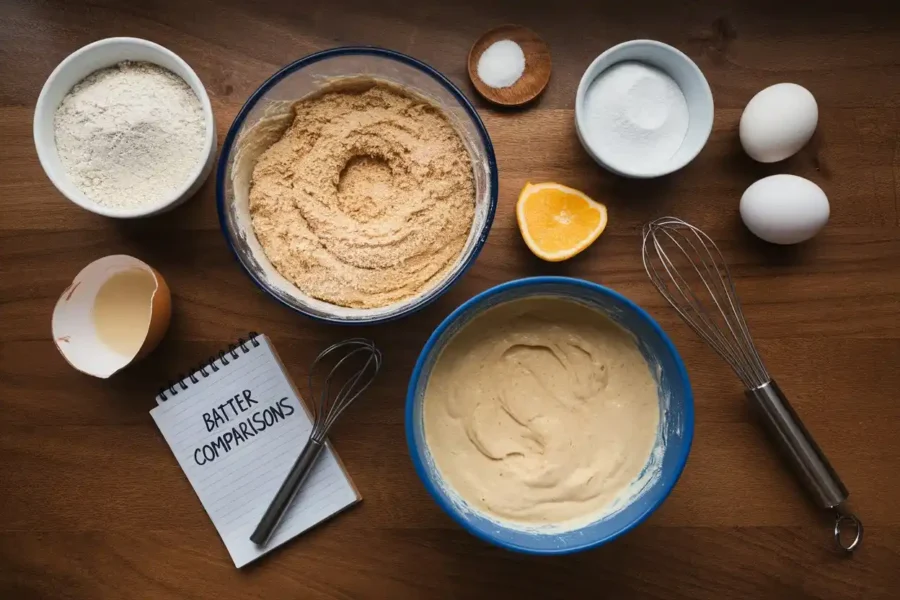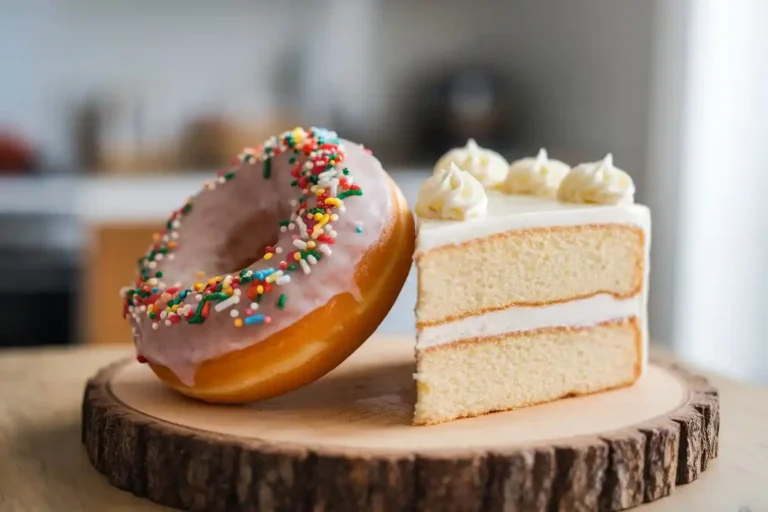When you bite into a fluffy donut or a moist cake, have you ever wondered what makes them different? The ingredients might seem similar, but the results couldn’t be more distinct. This article delves into the question: Is donut batter the same as cake? We’ll explore the key differences, similarities, and whether one can be used in place of the other. From the science behind their textures to practical kitchen tips, this guide will provide a clear understanding of these beloved treats.
Table of Contents
Understanding the Basics of Donut and Cake Batter
What Is Donut Batter?
Donut batter is the foundation of one of the world’s most beloved pastries. While there are two main types of donuts yeast-raised and cake donuts we’ll focus on cake donuts to stay on topic. Cake donut batter typically includes flour, sugar, eggs, and a liquid like milk or buttermilk. What makes it unique? Leavening agents, such as baking powder, which help it puff up when fried. Unlike yeast donuts, which need time to rise, cake donuts are quick and straightforward to prepare.
Cake donuts rely on a precise balance of dry and wet ingredients to achieve their signature dense yet tender texture. Too much liquid can make the batter runny, while too little can lead to dry donuts. The choice of liquid also adds subtle flavor think buttermilk for tang or milk for richness.
What Is Cake Batter?
Cake batter, on the other hand, is a more versatile creation. It’s designed to bake into a light, airy structure. Common ingredients include flour, sugar, eggs, butter or oil, and a leavening agent like baking powder or soda. Unlike donut batter, cake batter often incorporates more fat and sugar, making it sweeter and richer.
Cake batter also has a runnier consistency compared to donut batter. This allows it to spread evenly in a pan and rise smoothly in the oven. Depending on the recipe, additional ingredients such as cocoa powder or vanilla extract enhance the flavor profile.
Comparing the Two
At a glance, donut batter and cake batter might seem similar they both include basic pantry staples like flour, sugar, and eggs. But their ratios and preparation techniques create entirely different end products. While donut batter is thicker and optimized for frying, cake batter is more fluid and made for even baking.
Key Differences Between Donut and Cake Batter

Ingredient Ratios: Liquid to Dry Ingredients
One of the most significant differences between donut batter and cake batter lies in their ingredient ratios. Cake batter often has a higher liquid content, which creates a smoother, more fluid consistency. This allows it to spread evenly in a baking pan, resulting in the fluffy, light texture we associate with cakes. Donut batter, especially for cake donuts, uses less liquid, making it thicker and easier to shape or pipe before frying.
The balance of dry ingredients like flour and sugar also plays a key role. Donut batter usually leans on a higher flour-to-sugar ratio, giving it the structure it needs to hold its form during frying. Meanwhile, cake batter focuses on achieving a delicate balance for optimal rise and texture.
Leavening Agents in Donuts vs. Cakes
Leavening agents are the unsung heroes of baked goods, and their role in donut and cake batter highlights another crucial difference. In cake batter, baking powder or baking soda creates a consistent rise in the oven, giving cakes their signature airy texture. For donut batter, especially yeast donuts, the leavening process can include yeast, which requires time for fermentation.
Cake donuts, on the other hand, depend solely on chemical leaveners. The amount used is often higher than in cakes, helping the batter expand rapidly when it hits hot oil. This quick rise forms the characteristic crispy exterior of a donut.
Texture and Consistency
The textures of donuts and cakes couldn’t be more different. Donut batter is intentionally thicker to withstand frying, where it needs to maintain its structure while cooking quickly. Cakes, however, are all about achieving that melt-in-your-mouth softness, which is why the batter is much lighter and more fluid.
This variance in texture makes it challenging to interchange batters. For instance, if you pour cake batter into a fryer, it will scatter and fail to hold shape. Conversely, using donut batter in a cake pan could result in a dense and underwhelming cake.
Can Cake Batter Be Used to Make Donuts?
Challenges of Using Cake Batter for Donuts
At first glance, it may seem like you can use cake batter for donuts since their ingredients overlap. However, this substitution is not as straightforward as it seems. Cake batter’s high liquid content makes it unsuitable for frying. When submerged in hot oil, it tends to disperse and burn rather than hold a stable shape.
Another challenge is the lack of structural integrity in cake batter. Unlike donut batter, which is designed to create a crisp outer layer during frying, cake batter lacks the necessary density to achieve this result.
Tweaking Cake Batter for Donuts
That said, with some modifications, you can adapt cake batter to create donut-like treats. Reducing the liquid content and increasing the flour ratio can help thicken the batter. Adding a stabilizing ingredient, like an extra egg or a touch of cornstarch, can improve its frying potential.
Additionally, adjusting the leavening agents is crucial. Increasing the amount of baking powder or soda can provide the quick rise needed for frying. Some adventurous bakers even experiment with frying cake batter directly as fritters, though the results vary widely.
These tweaks show that while cake batter and donut batter are not inherently interchangeable, with creativity and some trial and error, you can create hybrid recipes that blend the best of both worlds.
Can Donut Batter Be Used to Make Cake?
Feasibility of Baking Donut Batter as Cake
The idea of using donut batter to bake a cake might sound fun, but it comes with its challenges. Donut batter is much denser than traditional cake batter, making it less suitable for creating the light, fluffy texture we expect in cakes. The reduced liquid content and higher flour ratio in donut batter yield a crumbly, more compact result when baked.
If you attempt to bake donut batter as a cake, you might end up with a dessert closer to a dense loaf or a pound cake rather than a typical layer cake. While this can be delicious in its own right, it’s not quite what you’d expect from a classic cake.
Limitations and Culinary Considerations
One of the major hurdles in using donut batter to make cake is the difference in cooking environments. Donut batter is designed for frying, where the hot oil quickly forms a crisp exterior. In an oven, however, this same batter may bake unevenly or fail to rise properly.
To make donut batter more suitable for cake baking, you can try adding extra liquid to loosen the consistency or incorporate an additional egg to enhance the batter’s structure. However, the results may still fall short of the softness and fluffiness of traditional cake.
If you’re looking for a unique dessert twist, consider shaping the donut batter into small molds, such as cupcakes or mini loaves. This way, you get the rich, slightly denser texture of donuts with a format more suited to baking.
Exploring Hybrid Recipes
Cake Donuts: A Perfect Middle Ground
One delightful way to combine elements of both donuts and cake is by making cake donuts. These treats use a batter that’s thicker than cake but shares some similarities in sweetness and flavor. Fried or baked, cake donuts offer the crispness of traditional donuts while maintaining a softer, more cake-like interior.
Experimenting with flavors can take cake donuts to the next level. From adding cocoa powder for a rich chocolate taste to infusing the batter with spices like cinnamon or nutmeg, there are endless variations. You can also top them with icing or glaze to bring in that classic donut charm.
Baking Donuts with Cake Batter
If you’ve ever wondered, Is donut batter the same as cake?, consider trying baked donuts made with cake batter. By using a donut pan, you can create beautifully shaped donuts with the texture and lightness of cake. This method works particularly well for vanilla, chocolate, or even funfetti-style cake batters.
For the best results, adjust the cake batter slightly by reducing the liquid and adding a bit more flour. This helps the batter hold its shape during baking while still delivering the soft texture you love in cakes. Finish with a glaze or sprinkles for a whimsical touch.
Creative Serving Ideas for Donut and Cake Hybrids
Donut Cakes for Celebrations
If you’re planning a party or special event, a donut cake can be a showstopper centerpiece. This isn’t about batter stacking actual donuts into tiers and decorating them like a cake is a fun, no-bake dessert option. Use frosting or sticky glazes to secure the donuts in place, then get creative with toppings like fruit, sprinkles, or powdered sugar.
Donut cakes are perfect for birthdays, weddings, or brunch gatherings. Their playful presentation makes them a hit with kids and adults alike. Plus, they’re easy to customize with different donut flavors, from classic glazed to rich chocolate.

Mini Treats for Dessert Buffets
For smaller gatherings or a dessert buffet, consider making mini donut-shaped cakes or cake-shaped donuts. These bite-sized treats combine the best of both worlds and are easy to serve. Use different glazes and toppings to offer variety, making sure there’s something for everyone.
Another creative serving idea is to pair donuts or donut cakes with dipping sauces. Chocolate ganache, fruit purees, or a creamy vanilla glaze make excellent accompaniments. These little touches elevate your dessert game and make every bite even more enjoyable.
Would you like to explore additional creative ideas or further expand on this content? Let me know!
FAQs About Donuts, Cake, and Their Relationship
Can You Make a Cake Out of Donuts?
Yes, you can! A donut cake is typically made by stacking whole donuts into a tiered shape and holding them together with frosting, glaze, or a sticky syrup. This is more of a fun, no-bake dessert idea than a traditional cake recipe. It’s perfect for events and brings a playful twist to the dessert table.
How Many Donuts Are Needed for a Donut Cake?
The number of donuts depends on the size of the cake you’re planning. A small donut cake might need just 10-15 donuts, while a larger, multi-tiered version could require 30 or more. Stacking donuts strategically and using glaze as an adhesive can help you achieve the desired shape and stability.
Does Dunkin’ Donuts Have a Donut Cake?
Dunkin’ Donuts does not officially sell a donut cake, but many customers have created their own using their donuts. These DIY creations have become a popular trend on social media, showcasing endless ways to personalize a donut cake with different flavors and decorations.
What Makes Donuts and Cake Different in Taste and Texture?
Donuts have a denser texture and a crisp exterior due to frying, while cakes are softer and more delicate, thanks to their higher liquid content and baking process. The flavors also differ, with donuts often featuring bolder, sweeter glazes and fillings compared to cakes’ subtle, layered flavors.
Conclusion and Practical Tips
When to Choose Cake Batter or Donut Batter
Whether you’re baking a cake or frying donuts, the choice of batter makes all the difference. Is donut batter the same as cake? Absolutely not! Donut batter is thicker and designed for frying, while cake batter is lighter and ideal for baking. Understanding these differences ensures you get the best results in your kitchen.
If you’re planning a dessert that needs a soft, fluffy texture, stick to cake batter. On the other hand, if you’re craving that classic fried treat, go for donut batter. Each type has its strengths, and using them appropriately will elevate your culinary creations.
Experimenting in the Kitchen
The beauty of cooking lies in experimentation. Don’t hesitate to tweak recipes or try hybrids, like using cake batter to make baked donuts. With a few adjustments, you can explore new textures and flavors. For example, adding extra leavening agents to donut batter could give you a firmer, denser loaf-style cake.
If you’re feeling inspired, why not try a recipe mash-up? Create baked donut holes with a hint of cake batter sweetness. Cooking is an adventure, and the more you explore, the more you’ll discover.

